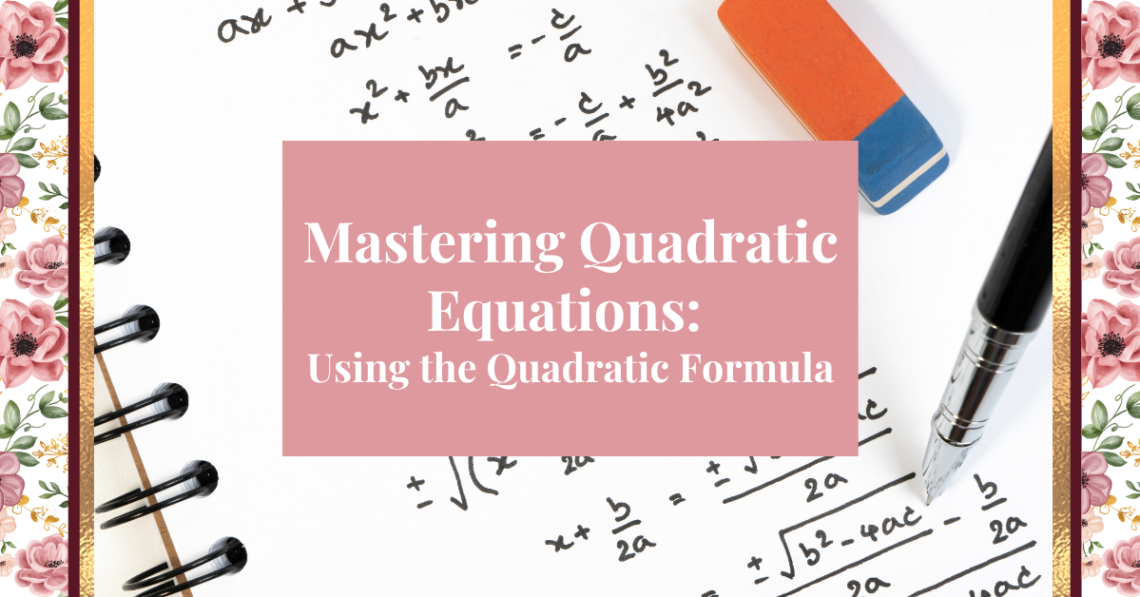Quadratic equations are one of the cornerstones of algebra. Whether you’re solving for x in an equation like \( ax^2+bx+c=0 \) , or analyzing the properties of a parabola, understanding how to solve quadratic equations is essential. One of the most powerful tools in solving these types of equations is the Quadratic Formula.
In this post, we’ll break down the Quadratic Formula, explain how to use it, and provide helpful tips for mastering quadratic equations in your math journey.
1. What is a Quadratic Equation?
A quadratic equation is any equation that can be written in the form: \(ax^2+bx+c=0\)
Where:
- a, b, and c are constants (real numbers),
- x represents the variable or unknown, and
- \( a \neq 0 \) (if a=0, the equation is linear, not quadratic).
The key characteristic of quadratic equations is that the highest power of the variable x is squared (\(x^2 \)), giving them their distinctive “U” or parabolic shape when graphed.
2. What is the Quadratic Formula?
The Quadratic Formula is a universal method used to solve any quadratic equation. It is derived from completing the square and can be applied to any quadratic equation in standard form.
The Quadratic Formula is: \( x = \frac{-b \pm \sqrt{b^2 – 4ac}}{2a} \)
Where:
- a, b, and c are the coefficients from the quadratic equation \(ax^2 + bx + c = 0\),
- The discriminant (\(b^2 – 4ac\)) determines the nature of the roots (real or complex),
- The ± symbol indicates that there are two possible solutions: one with a positive square root and one with a negative square root.
3. How to Use the Quadratic Formula
To solve a quadratic equation using the Quadratic Formula, follow these steps:
Step 1: Identify the coefficients a, b, and c
For the equation \(ax^2 + bx + c = 0\), identify the values of a, b, and c. These are the numbers that are attached to \(x^2\), x, and the constant, respectively.
Example: For the equation \(2x^2+3x−5=0\),
- a=2,
- b=3,
- c=−5.
Step 2: Plug the coefficients into the formula
Substitute a, b, and c into the Quadratic Formula. \( x = \frac{-b \pm \sqrt{b^2 – 4ac}}{2a} \)
Using the values from the example: \( x = \frac{-3 \pm \sqrt{3^2 – 4(2)(-5)}}{2(2)}\)
Step 3: Simplify inside the square root
Calculate the expression under the square root (the discriminant). \(b^2 – 4ac = 3^2 – 4(2)(-5) = 9 + 40 = 49\)
Step 4: Take the square root
Now find the square root of 49. \(\sqrt{49} = 7\)
Step 5: Solve for the two values of x
Now, substitute the square root value back into the formula and solve for the two possible values of x. \(x = \frac{-3 \pm 7}{4}\)
This gives us two possible solutions: \(x = \frac{-3 + 7}{4} = \frac{4}{4} = 1\) and \(x = \frac{-3 – 7}{4} = \frac{-10}{4} = -\frac{5}{2}\)
Thus, the solutions to the equation \(2x^2 + 3x – 5 = 0\) are: \(x=1\) or \(\frac{5}{2}\)
4. Understanding the Discriminant
The discriminant \(b^2 – 4ac\) plays an important role in determining the nature of the roots of the quadratic equation. It can be categorized into three types:
- latex]b^2 – 4ac > 0[/latex]: The equation has two distinct real roots.
- \(b^2 – 4ac = 0\): The equation has one real root (a repeated root).
- \(b^2 – 4ac < 0:\) The equation has two complex roots (no real solutions).
The discriminant essentially tells you how many real or complex solutions the quadratic equation has before you even calculate the roots.
Example:
For the quadratic equation \(x^2 + 4x + 5 = 0 \), we calculate the discriminant: \( b^2 – 4ac = 4^2 – 4(1)(5) = 16 – 20 = -4\)
Since the discriminant is negative, there are two complex roots for this equation.
5. Tips for Mastering the Quadratic Formula
Here are a few helpful tips to ensure you are using the Quadratic Formula correctly and mastering it:
Tip 1: Always check the discriminant first
Before solving, calculate the discriminant. This will give you an idea of what kind of solutions to expect, and it can help you double-check your work as you go.
Tip 2: Pay attention to signs
Make sure you carefully track the signs of a, b, and c. A common mistake is to misapply a negative sign during the process, which can throw off the entire calculation.
Tip 3: Simplify your answers
After solving, make sure to simplify your fractions or expressions as much as possible. For example, if you end up with \(\frac{6}{2}\), simplify it to 3.
Tip 4: Practice, practice, practice
The best way to master the Quadratic Formula is by solving a variety of quadratic equations. The more problems you solve, the more confident and efficient you’ll become with the process.
6. Common Mistakes to Avoid
- Forgetting to simplify: Always simplify your square roots and fractions to their simplest form.
- Misapplying the ± sign: The ± sign means you have two potential solutions, one where you add the square root and one where you subtract it. Don’t skip this step.
- Incorrectly handling negative coefficients: Pay extra attention to negative signs in front of b and c. The minus sign in front of b is crucial in the formula.
7. Conclusion
Mastering the Quadratic Formula is essential for solving quadratic equations efficiently and confidently. By understanding the steps involved and practicing regularly, you’ll become comfortable applying it to a wide variety of problems. The Quadratic Formula is a versatile tool that not only helps you solve algebraic equations but also lays the foundation for understanding more advanced mathematical concepts.
Have you ever used the Quadratic Formula in a real-world situation, or do you have a favorite method for solving quadratic equations? Share your thoughts in the comments below! Let’s continue the conversation and help each other improve our math skills.





